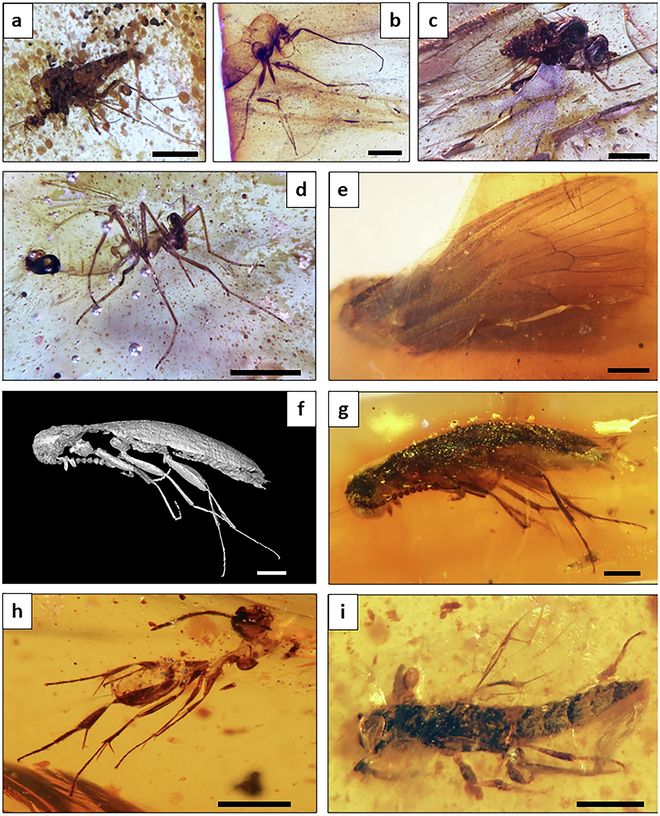Fossilized resin reveals rainforest full of insects and spiders 112 million years ago

For a very long time, the amber deposits of South America lacked one thing, and one thing in particular: insects.
But a September 2025 study in Earth and Environment Communications describes the earliest amber deposits of South America including insects from the Cretaceous (approximately 143 million to 66 million years ago).
The deposits, discovered in Ecuador, include a mix of material from insects, springtails, spiders and plants, painting a picture of South America’s resin-rich forests around 112 million years ago, when the supercontinent of Gondwana was beginning to break up.
Cretaceous amber
dh) Small or medium-sized pieces of amber, formed from resin exuded from trunks or branches under aerial conditions, are rare, but some of them contain bio-inclusions.
(Short image by Delclòs, X. et al.)
Amber traps many things – from insects and spiders to plant spores and pollen – that aren’t always preserved in the fossil record.
These trapped objects were found in amber 230 years ago, but almost all Cretaceous “bio-inclusions” to date have appeared in northern hemisphere amber, obscuring southern environments and ecosystems.
“Since the Cretaceous, such ‘bio-inclusions’ have been almost exclusively known from sites in the northern hemisphere,” said Mónica Solórzano-Kraemer, study author and scientist at the Senckenberg Research Institute and the Natural History Museum in Frankfurt, in a press release. “Our understanding of the biodiversity and ecosystems of the southern hemisphere during this period”, adds the arthropod specialist in the press release, is therefore “very limited”.
Learn more: What are fossils and where are they most found?
Studying South American Amber
To fill this gap in the fossil record, Solórzano-Kraemer and a team of researchers turned to amber from the Hollín Formation in eastern Ecuador. This sedimentary rock formation features two types of amber or fossilized resin approximately 112 million years old, which have solidified among the roots of trees underground or among the trunks and branches of trees on the surface, thanks to the hardening of the resin in the air.
By isolating 21 bio-inclusions from around 60 samples of air-stiffened amber, the team identified a series of insect bodies and body parts, a single springtail, a single spider web, and a selection of plant spores and pollen, almost all of which were well preserved. While the insect fossils came from five orders of insects, including Diptera (flies), Coleoptera (beetles), and Hymenoptera (ants and wasps), the fossilized spider web came from an orb-weaving species, which spun its web in an orbicular or spiral shape.
A Cretaceous “time capsule”

A) Diptera; b) Diptera; c) Diptera; d) Trichoptera; f) Beetles; g) Beetles; h) Hymenoptera; I) Hymenoptera.
(Short image by Delclòs, X. et al.)
Taken together, the fossils suggest that South America’s forests were warm and humid during the Cretaceous, when South America began to separate from Gondwana.
“Our results suggest wet conditions,” Solórzano-Kraemer said in the release. “We assume that 112 million years ago there existed in equatorial Gondwana a humid, densely forested habitat, already characterized by flowering plants.”
In fact, the team also analyzed the amber itself, in addition to its inclusions, identifying its source as something similar to an araucaria. This type of tree would thrive in the same type of environment that would suit the insects, springtails and spiders seen in amber, still stuck there after 112 million years.
“The recently discovered amber deposit is of crucial importance for paleontology,” Solórzano-Kraemer added in the statement, emphasizing the importance of the team’s research. “It not only provides direct evidence of a resin-rich forest ecosystem, but also its diverse arthropods in the Early Cretaceous. The ambers and their inclusions allow us to open a ‘time capsule’ to explore the biodiversity and ecosystems of the Southern Hemisphere.”
Learn more: Amber May deep-sea deposits document massive 116-million-year-old tsunamis
Article Sources
Our Discovermagazine.com editors use peer-reviewed research and high-quality sources for our articles, and our editors review the articles for scientific accuracy and editorial standards. See the sources used below for this article:




